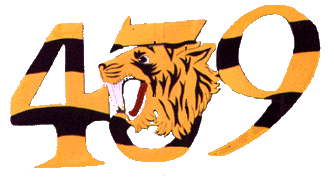|
In the last days of October the squadron moved its mess from the unheated ex German guard room on the airfield to a school in the nearby town. The building formerly had been used for prospective nuns a fact which, it was suggested, might have its effect upon the moral standards. That the move had at least one benefit was obvious a few nights later when some German aircraft hovering around the airfield dropped flares and a bomb which exploded near the former mess. On the airfield the airmen had by now abandoned their tents in favour of small wooden huts which they had constructed with lumber salvaged from blitzed hangars and buildings. Earlier reports that 15O prefabricated temporary buildings would be erected for them had proved to be just rumours. The area around the
disporsal, which had looked like a carpentry school for some days, now resembled a squatter's settlement, amidst which the pilots'
tent with its two huge smoke stack, stood out like a miniature foundry. Inside it, however, life was quite domestic at times with morning and afternoon tea and coffee, the enticing aroma of which seemed to attract every dog in the vicinity! In the two months since leaving Lantheuil on the Norman beach head the squadron's
bombing and strafing activities had yielded a rich harvest of vehicles, vessels, trains and rail lines.
It is difficult to compile complete statistics of flamers, smokers, damaged and cuts, but the following figures may be taken as a conservative, minimum estimate of the results achieved in September and
October: (1)
MET 30 flamers, 14 smokers, 51 damaged
HDT 3 damaged
Ammunition
trains 1 destroyed
Locomotives 2 (at least) destroyed, 29 damaged
R.R. cars 12 (at least) damaged
Barges, tugs 1 destroyed, 1 smoker, 24 damaged
and boats
Bridges 2 destroyed, 1 damaged
Enemy aircraft 1 destroyed, 1 damaged
Miscellaneous 1 petrol dump destroyed, 4 buildings (at least) damaged
(1)
MET mechanized enemy transport
HDT horse drawn transport
Since embarking on the rail interdiction campaign on 26 September the squadron had made, at a minimum estimate, 58 cuts. Evidence of the efficacy of this aerial campaign to
paralyze enemy rail traffic was found in the reports of the reconnaissance pilots who stated that all rail movement past the Dutch border had virtually ceased.
  
Copyright
©1998-2016 Michael T. Melnick. All rights reserved
the
unofficial homepage of  Tiger
Squadron Tiger
Squadron
.
.
|